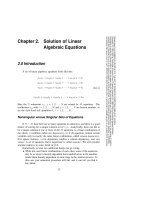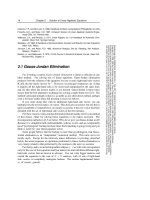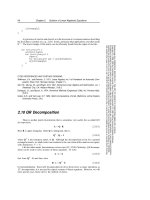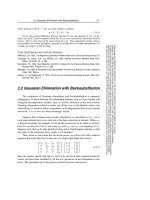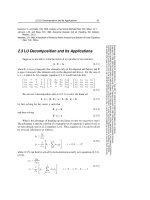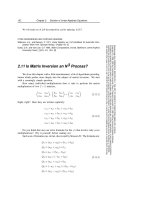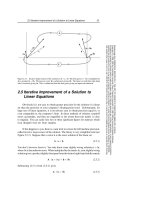solution of linear equations using gaussian elimination
Bạn đang xem bản rút gọn của tài liệu. Xem và tải ngay bản đầy đủ của tài liệu tại đây (228.04 KB, 17 trang )
Solution of linear equations
using Gaussian elimination
FAQ
Reference
s
SummaryInfo
Resources
Learning Objectives
Introduction
Gaussian elimination
method
Gaussian elimination
procedure
Programming
exercise
Home
HOME
Introduction
Gaussian Elimination
Method
Gaussian Elimination
Procedure
Programming Exercise
Resources
FAQ
Reference
s
SummaryInfo
Resources
Learning Objectives
Introduction
Gaussian elimination
method
Gaussian elimination
procedure
Programming
exercise
Learning Objectives
Learning objectives in this module
1. Develop problem solution skills using computers and numerical
methods
2. Review the Gaussian elimination method for solving
simultaneous linear equations
3. Develop programming skills using FORTRAN
New FORTRAN elements in this module
-use of NAG-library
FAQ
Reference
s
SummaryInfo
Resources
Learning Objectives
Introduction
Gaussian elimination
method
Gaussian elimination
procedure
Programming
exercise
Introduction
Solution of sets of linear equations is required in many petroleum
applications. Many methods exist for this purpose, direct methods as
well as iterative methods. The reference mentioned in the end may
be consulted for a review of such methods.
A direct method frequently used in petroleum applications is the
Gaussian elimination method, and the simplest form of this method
will be discussed below. First, let’s review the concept of
simultaneous linear equations. A set of linear simultaneous
equations may be written as:
a
11
x
1
+a
12
x
2
+ a
13
x
3
+ + a
1N
x
N
= d
1
a
21
x
1
+ a
22
x
2
+ a
23
x
3
+ + a
2N
x
N
= d
2
a
31
x
1
+ a
32
x
2
+ a
33
x
3
+ + a
3N
x
N
= d
3
a
M 1
x
1
+ a
M 2
x
2
+ a
M 3
x
3
+ + a
MN
x
N
= d
M
.
.
.
.
.
.
.
FAQ
Reference
s
SummaryInfo
Resources
Learning Objectives
Introduction
Gaussian elimination
method
Gaussian elimination
procedure
Programming
exercise
Introduction
Here we have a total of N unknowns (x
j
, j=1, 2… N), related
through M equations. The coefficients in the left sides of the
equations (a
ij
, i=1, 2… N ; j=1, 2… M ) are known parameters,
and so are also the coefficients on the right side (b
i
, i=1, 2… M).
a
11
x
1
+a
12
x
2
+ a
13
x
3
+ + a
1N
x
N
= d
1
a
21
x
1
+ a
22
x
2
+ a
23
x
3
+ + a
2N
x
N
= d
2
a
31
x
1
+ a
32
x
2
+ a
33
x
3
+ + a
3N
x
N
= d
3
a
M 1
x
1
+ a
M 2
x
2
+ a
M 3
x
3
+ + a
MN
x
N
= d
M
.
.
.
.
.
.
.
FAQ
Reference
s
SummaryInfo
Resources
Learning Objectives
Introduction
Gaussian elimination
method
Gaussian elimination
procedure
Programming
exercise
Introduction
The equations may alternatively be written in a compact form:
where A is the coefficient matrix, and b is the right hand side vector:
A⋅ x = b
A =
a
11
a
12
a
1N
a
21
a
22
a
2N
a
M 1
a
M 2
a
MN
b =
b
1
b
2
b
M
x =
x
1
x
2
x
M
If the number of unknowns
is equal to the number of
equations,
N=M
, we may be
able to solve the set of
equations, provided that the
equations are unique.
Gaussian Elimination Method
FAQ
Reference
s
SummaryInfo
Resources
Learning Objectives
Introduction
Gaussian elimination
method
Gaussian elimination
procedure
Programming
exercise
Gaussian elimination method
For simplicity, let’s use the following set of 3 equations and 3
unknowns, ie. N=3 and M=3, in order to illustrate the Gaussian
elimination method:
The method starts by multiplying Eq. (4) by –a
21
/a
11
and then
add it to Eq. (5). The resulting equation becomes:
We then multiply Eq.(4) by and add it to Eq.(6), resulting in:
a
11
x
1
+
a
12
x
2
+
a
13
x
3
=
d
1
a
21
x
1
+
a
22
x
2
+
a
23
x
3
=
d
2
a
31
x
1
+
a
32
x
2
+
a
33
x
3
=
d
3
(4)
(5)
(6)
′
a
22
x
2
+ ′
a
23
x
3
= ′
d
2
′
a
32
x
2
+ ′
a
33
x
3
= ′
d
3
FAQ
Reference
s
SummaryInfo
Resources
Learning Objectives
Introduction
Gaussian elimination
method
Gaussian elimination
procedure
Programming
exercise
Gaussian elimination method
The set of equation has now become
Next, we multiply Eq. (8) by –a’
32
/a’
22
and add it to Eq. (9), so that the
set of equations become:
This completes the first part of the Gaussian elimination method, called
the forward elimination process.
a
11
x
1
+
a
12
x
2
+
a
13
x
3
=
d
1
′
a
22
x
2
+ ′
a
23
x
3
= ′
d
2
′
a
32
x
2
+ ′
a
33
x
3
= ′
d
3
(7)
(8)
(9)
a
11
x
1
+
a
12
x
2
+
a
13
x
3
=
d
1
′
a
22
x
2
+ ′
a
23
x
3
= ′
d
2
′ ′
a
33
x
3
= ′ ′
d
3
(10)
(11)
(12)
Continue to the Second Part
FAQ
Reference
s
SummaryInfo
Resources
Learning Objectives
Introduction
Gaussian elimination
method
Gaussian elimination
procedure
Programming
exercise
Gaussian elimination method
Eq. (12) may now be used to solve directly for x
3
:
After completion of the forward elimination process, determined
the last unknown of the vector (x
3
) by Eq. (13), we will perform a
back substitution process. This simply means that as the
unknowns are calculated, in our simple example from x
3
and
downwards, they are substituted into the equations above, and
the next unknown may be computed. For Eqs. (12) and (11) this
process is carried out as follows:
Based on the example above, we may formulate a general
procedure for the forward elimination, solution for the last
unknown, and back substitution to get the rest of the unknowns
x
3
= ′ ′
d
3
/
′ ′
a
33
x
2
=
(
′
d
2
− ′
a
23
x
3
) /
′
a
22
x
1
=
(d
1
−
a
12
x
2
−
a
13
x
3
) / a
11
(13)
(14)
(15)
Gaussian Elimination Procedure
FAQ
Reference
s
SummaryInfo
Resources
Learning Objectives
Introduction
Gaussian elimination
method
Gaussian elimination
procedure
Programming
exercise
Gaussian elimination procedure
1) Forward elimination:
2) Solving for x
N
:
3) Back substitution:
a
i, j
= a
i,j
+ a
k,j
−
a
i,k
a
k,k
,
j = k +1,n
( )
, i = k +1,n
[ ]
, k =1,n −1
d
i
= d
i
+ d
k
−
a
i,k
a
k ,k
, i = k +1,n
( )
, k = 1,n − 1
x
N
=
d
N
a
N,N
x
i
=
1
a
i,i
d
i
− a
i, j
j=i+1
n
∑
x
j
, i = n −1, ,1
FAQ
Reference
s
SummaryInfo
Resources
Learning Objectives
Introduction
Gaussian elimination
method
Gaussian elimination
procedure
Programming
exercise
Programming Exercise
Make a FORTRAN program consisting of a main program, that
reads the coefficients of the system of equations (n, a
1,1
…a
n,n
,
d
1
…d
n
) from an input file (IN.DAT) and writes the results (x
1
…x
n
)
to an out-file (OUT.DAT), and a subroutine, SUBROUTINE
GAUSS(X,A,D,N), that uses the Gaussian elimination method in
order to solve the set of equations and returns n values of x to
the main program
Test the program on the following set of equations:
+27=+6t+4s-2z+5y3x
-19=-9t+3s+8z-7y5x
-33=-2t-3s+6z4y
+53=+3t+9s-3z-2y8x
-35=+7t-5s+4z+3y2x
Continue
Push
FAQ
Reference
s
SummaryInfo
Resources
Learning Objectives
Introduction
Gaussian elimination
method
Gaussian elimination
procedure
Programming
exercise
Programming Exercise
The Petra-server includes a NAG-library of scientific subroutines.
Find a subroutine in this library (use naghelp) that may be used
for solution of simultaneous equations (Gaussian elimination
method or some other method). Modify the program above so
that is asks you on the screen if you want to use the
programmed Gaussian-routine or the NAG-routine for the
solution. Check that the solutions from the two methods are
identical. (Note that all real variables should be declared as
REAL*8 (double precision) since the NAG-routines require this)
The NAG-routine may be linked in by the command
xlf –o prog fil.f –L/localiptibm3/lib –l nag
Resources
FAQ
Reference
s
SummaryInfo
Resources
Learning Objectives
Introduction
Gaussian elimination
method
Gaussian elimination
procedure
Programming
exercise
Resources
Introduction to Fortran
Fortran Template here
The whole exercise in a printable format here
Web sites
Numerical Recipes In Fortran
Fortran Tutorial
Professional Programmer's Guide to Fortran77
Programming in Fortran77
Fortran Tem plate
Sol u t i on of lin ear
equation using Gaussi
FAQ
Reference
s
SummaryInfo
Resources
Learning Objectives
Introduction
Gaussian elimination
method
Gaussian elimination
procedure
Programming
exercise
General information
Title: Solution of linear equations using Gaussian elimination
Teacher(s): Professor Jon Kleppe
Assistant(s): Per Jørgen Dahl Svendsen
Abstract: Provide a good background for solving problems within
petroleum related topics using numerical methods
4 keywords: Linear equations, Gaussian elimination, matrices,
subroutines
Topic discipline:
Level: 2
Prerequisites: None
Learning goals: Develop problem solution skills using computers and
numerical methods
Size in megabytes: 0.6 MB
Software requirements: MS Power Point 2002 or later, Flash Player 6.0
Estimated time to complete:
Copyright information: The author has copyright to the module and use of the
content must be in agreement with the responsible
author or in agreement with
.
About the author
FAQ
Reference
s
SummaryInfo
Resources
Learning Objectives
Introduction
Gaussian elimination
method
Gaussian elimination
procedure
Programming
exercise
FAQ
No questions have been posted yet. However, when questions are asked
they will be posted here.
Remember, if something is unclear to you, it is a good chance that there are
more people that have the same question
For more general questions and definitions try these
Dataleksikon
Webopedia
Schlumberger Oilfield Glossary
FAQ
Reference
s
SummaryInfo
Resources
Learning Objectives
Introduction
Gaussian elimination
method
Gaussian elimination
procedure
Programming
exercise
References
W. H. Preuss, et al., “Numerical Recipes in Fortran”, 2nd edition
Cambridge University Press, 1992
References to the textbook :
Gauss Jordan elimination: page 27
Gaussian Elimination with backsubstitution: page 33
FAQ
Reference
s
SummaryInfo
Resources
Learning Objectives
Introduction
Gaussian elimination
method
Gaussian elimination
procedure
Programming
exercise
Summary
Subsequent to this module you should
be familiar with the Gaussian Elimination Method
have a good feel for how Nag routines are used
know how to efficiently use subroutines
have obtained a better understanding on solving problems
in Fortran
